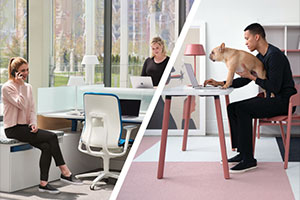 If one thing’s for certain, it’s that the Post-Pandemic “Return to Normal” will look nothing like the workplace of the past. The Future of Work will likely include more choice and flexibility than in the past. For organizations that prioritize preserving their in-person office experience and culture, the future state may include a hybrid work arrangement or flexible schedules. While this sounds like a viable compromise for the impossible task of making everyone happy, there are certain employees that will be impacted more than others.
If one thing’s for certain, it’s that the Post-Pandemic “Return to Normal” will look nothing like the workplace of the past. The Future of Work will likely include more choice and flexibility than in the past. For organizations that prioritize preserving their in-person office experience and culture, the future state may include a hybrid work arrangement or flexible schedules. While this sounds like a viable compromise for the impossible task of making everyone happy, there are certain employees that will be impacted more than others.
For example, during a year of self-isolation, introverts were able to thrive while working remotely. While extroverts struggled with the lack of spontaneous conversation, introverts enjoyed the ability to choose when and how often they connect with colleagues. Many people reported fewer drop-in conversations than they experienced while working in an office setting. And while camera-on Zoom meetings are especially draining for introverts, many organizations learned to be flexible and accommodating of individuals who chose to keep their camera turned off.
Returning to the office, even with a hybrid/flexible schedule, may be daunting for introverts. One of my introverted colleagues shared that the hybrid schedule was more exhausting than working from the office full-time. From her perspective, she is only able to be productive for 3 days per week, and the other 2 days are spent in non-stop interactions with colleagues who have been socially starved for the past 18 months. “I’ve been tempted to just sit with my chair facing my cubicle door because I know within 5 minutes, someone will stop by for a quick chat.”
And while we should be careful not to generalize, there is often a similar challenge for neurodiverse employees. For differently-abled individuals who are on the Autism Spectrum or who have ADHD, there are unique sensory-related experiences that accompany working on-site. This is especially true for the increasingly popular open workspace design. While working remotely, differently-abled individuals are able to control lighting, odors, and audio distractions better than when they’re sharing the space with dozens of coworkers.
Of course, everyone’s preferences and home office situations are distinct. For some individuals, going back to the office means more structure and fewer distractions from kids, pets, and home responsibilities.
The key takeaway is there is no one-size-fits-all solution for the work arrangements that will meet everyone’s needs. The best we can do is offer choice where possible, and have open discussions about the accommodations each person may need in order to be effective. Offering flexible workspaces and empowering employees to set boundaries will go a long way towards improving productivity, engagement, and employee satisfaction. Start by having an open conversation with each employee to learn what environment suits them best and keep an open mind while exploring how to meet their needs.
